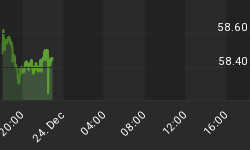Economic growth continued to show signs of moderating this week. The ISM manufacturing index fell 1.4 points to 50.9 in March. There has been a lot of discussion that the recent weakness in the manufacturing sector was due to an inventory reduction cycle. According to the recent survey, manufacturers believe this as well. The index tracking how manufacturers think customers' inventory levels are dropped five points to 48, it's the first time manufacturers have felt their customers' inventories were too small since September 2006. The backlog of orders also dropped back below 50. Unfortunately for manufacturers there does not appear to be a rush to restock either. The new order index fell 3.3 points to 51.6. Employment slipped below fifty again after a one-month reprieve. Perhaps the biggest surprise was the surge in prices paid. Prices paid soared 6.5 points to 65.5, the highest level since August.
The non-manufacturing survey also revealed slower growth in March. The ISM reported that the non-manufacturing survey fell 1.9 points to 52.4, which was the lowest level since April 2003. New orders fell one point. Employment dropped 1.4 points to 50.8, the lowest level since July 2004. Similar to the manufacturing survey, prices paid jumped. The 9.5 point jump to 63.3 was the largest increase since September 2005 when energy prices soared during the aftermath of the hurricanes that devastated the Gulf Coast.
Last week, the Chicago PMI jumped 13.8 points to 61.7, the largest monthly gain since the index started in 1968. The Chicago PMI was almost a mirror image of the ISM survey. Production and new orders jumped 13.7 points and 23.5 points respectively, while prices paid dropped 4.1 points.
Factory orders increased 1.0% in February. This was below the 1.8% increase economists predicted. Compared to last year, factory orders were 1.1% lower and non-defense capital goods excluding aircraft rell 2.2% on a year-over-year basis. This was the first time this data series declined on a year-over-year basis since February 2004.
March auto sales fell 1.8% compared to last year to a 16.3% annualized rate. This was lower than estimates of 16.5 million. All three domestic automakers posted lower year-over-year sales for March. GM's sales fell 7.4%, Ford sales dropped 12.4% and Chrysler had an 8.0% drop. Most of the drop in sales was due to reduced fleet sales. Conversely, Toyota (up 7.7%), Honda (8.0%) and Nissan (3.9%) all increased the number of autos sold compared to last year. This caused the market share of the domestic automakers to drop 360 basis points.
Pending home sales unexpectedly increased 0.7% in February. While the news halted a seemingly continuous decline in the homebuilders, two weeks ago the National Association of Realtors reported that existing home sales rebounded, but new home sales remained weak. Investors have used any positive news to proclaim that a bottom of the housing market is near. While it will be difficult to pinpoint when the housing market will bottom, recent developments have it more probable that another shoe will drop before the market rebounds.
Norfolk Southern reported that first quarter earnings were less then analysts expected. The company said that earnings declined 3% compared to last year. Volumes declined 4.4% due to weak automotive and housing related shipments. The company also said operating expenses were higher due to adverse weather.
First quarter earnings are expected to increase only 3.8%, down 60 basis points from last week and down from 8.7% at the beginning of the quarter. Consumer discretionary companies are expected to have earnings contract by 10% during the first quarter. The loss is mostly confined to the automotive and homebuilding sectors. Of the thirty-two industries included in the discretionary sector, eleven are expected to post lower earnings. In aggregate, earnings for these eleven industries are expected to be $3.2 billion lower in the first quarter than last year. This overwhelms the $1.5 billion increase expected in the other twenty-one industries. Digging a little deeper, Thomson Financial found that auto manufacturers and homebuilders account for 83% of the decline, or $2.6 billion. If these seven companies (two auto manufacturers and five homebuilders) are excluded earnings for the sector jumps to 6% from -11%. Additionally, earnings growth for the entire S&P 500 increases from 3.8% to 5.9%.
The economic backdrop has started to deviate from the "Goldilocks" scenario widely disseminated earlier this year. Pricing pressure has started to increase again and there have been numerous indications that the manufacturing sector has moderated. The ISM non-manufacturing survey revealed that the service side of the economy has slowed as well. The slowing growth and continued pricing pressure has caused some to discuss the possibility of stagflation. David Rosenberg, economist for Merrill Lynch, put out a note this week saying he started "to consider stagflation as a serious threat to the inflation outlook." He does say that he does not foresee a return of the 1970's style stagflation with "negative economic growth rates, sky-high inflation (total and core) and sharply higher unemployment rates. Instead, this will be a "modern-day" stagflation with economic growth near 2%, which would "not be slow enough to put a dent in classic measure of inflation and inflation expectations.
















